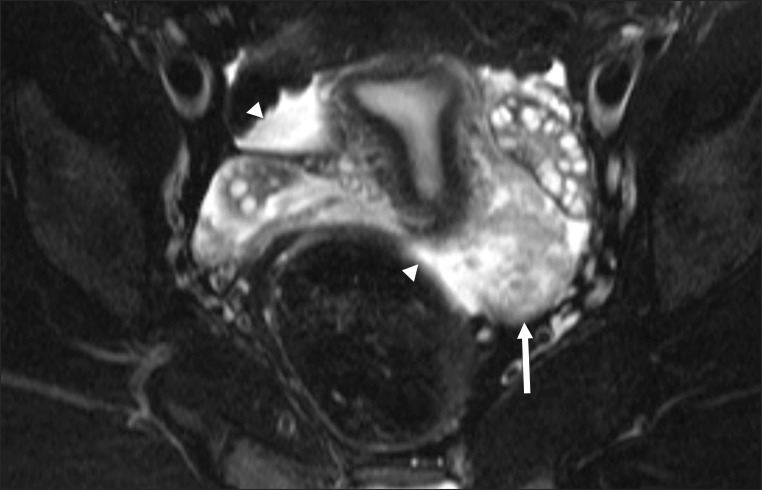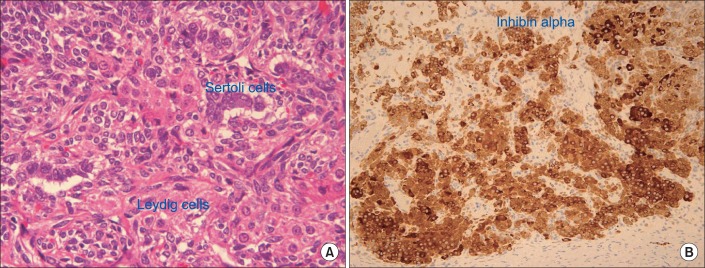Abstract
Ovarian Sertoli-Leydig cell tumors are rare sex cord-stromal tumors, accounting for less than 1% of ovarian tumors. Majority of these tumors are benign and unilateral, only 3-5% are bilateral. These patients present with clinical features of virilization due to excessive secretion of testosterone from the tumor, however 50% may have no endocrine symptoms. We report a case of poorly differentiated Sertoli-Leydig cell tumour in a woman diagnosed during routine investigation of infertility. She had two spontaneous successful pregnancies after tumor excision laparoscopically.
Keywords: Laparoscopy, Malignancy, Pregnancy, Sex-cord stromal tumor
INTRODUCTION
Sertoli-Leydig cell tumors are very rare gonadal tumor of sex cord-stromal tumor comprising 0.1% to 0.5% of ovarian tumors, and most of them are seen in women younger than 40 years. These tumors are composed of the cells of the testis at various stage of development [1]. Many of them are virilizing, but some type of tumor has no endocrinological property, and in another type of tumor, even produces estrogen [2]. We have recently encountered a case in which a woman affected from a poorly differentiated Sertoli-Leydig cell tumor of ovary, and she was operated with laparoscopically, allowing future pregnancy. We report a case with some literature review.
CASE REPORT
A 23-year-old woman was referred to the gynecology clinic for subfertility and an ovarian tumor. She had been married for two years and reported having irregular periods every two to three months. She reported having gained 16 kg after marriage and developing excess growth of fine hair all over her body and face. She did not have galactorrhoea, acne, altered appetite, or thyroid symptoms. Apart from treatment for infertility (ovulation induction with clomiphene citrate) her medical history was unremarkable. There was no family history of diabetes or hypertension.
On examination she was moderately built with a body mass index of 26 and normal secondary sexual characters. She had a slight excess of fine hair on her face and abdomen. Examination of the breasts and thyroid was normal. No masses were found on examination of the abdomen, and on bimanual examination the uterus was normal with no adnexal masses.
A routine transvaginal scan in the outpatient clinic showed bilateral polycystic ovaries with a 4 cm complex cystic lesion in the left ovary (possibly a dermoid cyst) and minimal free fluid in the pouch of Douglas. The patient's serum testosterone was raised (4.2 nmol/L, upper limit of normal 2.6 nmol/L) but markers of epithelial ovarian cancer (CA-125) and germ cell tumors (alfa-fetoprotein [AFP] and lactate dehydrogenase) were normal other hormone levels (follicle stimulating hormone, luteinizing hormone, estradiol, prolactin, thyroid stimulating hormone, dehydroepiandrosterone sulphate [DHEAS]) were normal.
The mass would have disappeared if it were a simple hemorrhagic corpus luteal cyst of the ovary. MRI was requested for a persistent mass after 3 months. It revealed a normal uterus and both ovaries with normal developing follicles, free fluid in the pouch of Douglas. A 4.2×3.2×4.1 cm heterogeneous solid mass with necrotic areas and intense contrast enhancement with high cellularity was seen in the pouch of Douglas adjacent to the left ovary. No evidence of continuity of the mass or infiltration into the left ovary was seen. There was no evidence of pelvic lymphadenopathy or focal destructive lesion in bones. A provisional MRI diagnosis was a malignant mass on the left side of the pouch of Douglas not infiltrating the ovaries (Fig. 1)
Fig. 1.
Axial fat saturated T2 weighted image of pelvis showing uterus and both ovaries identified a heterogeneous solid mass close to the left ovary (arrow) and a small amount of free fluid in the pelvis (arrowheads).
Further investigations were requested for a possible source of primary malignancy. CT abdomen and chest, breast ultrasound, upper gastrointestinal endoscopy and colonoscopy were all normal. As the nature of the mass was unclear and MRI was suggestive of a possible malignancy, the couple was counseled for diagnostic laparoscopy, removal of mass, and if clinically needed for salpingo-oophorectomy. The couple refused removal of the ovary, as she was asymptomatic and was worried about her fertility. She consented to laparoscopy, which revealed a pedunculated ovarian mass of 6×5×3 cm in size, dark in color with solid and cystic components attached to the left ovary by a thick pedicle of 1 cm. Normal uterus and both ovaries with ascitic fluid in the pouch of Douglas was observed. The pedicle was ligated, divided and the mass was removed intact without a breach in the capsule. Ascitic fluid was sent for cytology. Frozen section was not performed as the couple did not consent to any further intervention than the removal of the mass. Thus the procedure was laparoscopic excision of the mass conserving both ovaries.
Microscopic examination of the tumor showed a circumscribed neoplasm surrounded by loose fibroconnective tissue and variably sized cellular nodules in an edematous/loose connective tissue stroma containing thick walled blood vessels. The nodules were composed of sheets of hyperchromatic cells with oval to spindle shaped nuclei, small nucleoli and indistinct cytoplasm intermingled in places with clusters of pale cells, luteinized cells and aggregates of Leydig cells. Acinar/tubular structures lined by cuboidal cells with eosinophilic cytoplasm were focally noted and cord like arrangement of the hyperchromatic cells was also focally observed (Fig. 2A). There was no evidence of heterologous components. Immunohistochemical staining showed Sertoli cells positive for inhibin (Fig. 2B), Melan A and calretinin, but was negative for epithelial membrane antigen, placental alkaline phosphate, cytokeratin (CK)-7, CK-20, AFP, and CA-125. Based on the histopathology a diagnosis of intermediate to poorly differentiated Sertoli-Leydig cell tumor without heterogeneous element was made. Peritoneal fluid was positive for malignant cells.
Fig. 2.
(A) Sertoli cells surrounded by Leydig cells (H&E, ×60). (B) Immunohistochemistry studies showing strong positive staining for inhibin (×20).
The couple was counseled in detail by a multi-disciplinary team of gynecologist, oncologist, surgeon and oncology nurse about further evaluation and treatment including staging laparotomy, but they refused and went abroad for a second opinion. Serum testosterone estimated after 3 months was 2.4 nmol/L, and the pelvic ultrasound scan was normal.
She was managed conservatively by the medical oncologist and in the meantime she conceived twice spontaneously and delivered vaginally at term two healthy babies. At present, the first baby is 3 years of age and second baby is 6 months old. Her pelvic ultrasound scans repeated after the second delivery is within normal with no mass or ascites seen, and the serum testosterone is within normal range. Serum inhibin follow-up was done by a medical oncologist in another hospital.
DISCUSSION
Sertoli-Leydig cell tumors, also known as arrhenoblastomas, are a member of sex cord stromal tumors of the ovary and testes that are most frequently seen in the second to fourth decade of life [3]. The tumor typically produces androgens and clinical virilization/progressive defeminization is seen in about 50% of patients [4]. Signs of virilization include oligomenorrhea followed by amenorrhea, breast atrophy, acne, hirsutism, clitoromegaly, deepening of voice, and receding hair line.
Elevated serum testosterone levels greater than 200 ng/dL are diagnostic of an adrenal and ovarian tumour [5]. DHEAS and dexamethasone suppression tests are used if the tumor cannot be located and the adrenal cause of hyperandrogenism is to be ruled out. In our patient the testosterone level was not very high and the DHEAS was normal. Ulrasonogrphy, CT scanning, and MRI of the pelvic will help in making the clinical diagnosis. In our case routine ultrasound detected the pelvic mass and MRI suggested that it had malignant features.
The important prognostic factors for Sertoli-Leydig cell tumours are age of patient, degree of differentiation and stage of the tumor [6]. These tumors are considered to be of unknown malignant potential. Malignant potential as given by Young and Scully [4] is none in a well-differentiated tumor, about 11% in the intermediate types, 59% in poorly differentiated tumors, and about 19% in tumors with heterologous elements. As these tumors are mostly unilateral, conservative treatment with unilateral salpingo-oophorectomy and evaluation of the contralateral ovary is recommended in reproductive age patients. For patients who have completed their families, hysterectomy and bilateral salpingo-oophorectomy is appropriate. For patient with poorly differentiated or advanced tumors, postoperative chemotherapy is recommended. In our patient the histopathology of tumor showed intermediate to poorly differentiated Sertoli-Leydig cell but the patient completely refused staging surgery or chemotherapy.
Follow-up after removal of the tumor should be done every 3 months during the first year, every 4 months during the second year, every 6 months during the third year, and annually thereafter for the rest of their lives [5]. As most recurrences occur within 36 months but are also known to occur as late as 35 years, lifelong follow-up is mandatory [6]. During follow up visits a detailed history, examination, serum testosterone levels and ultrasound of the abdomen and pelvis are recommended. Inhibin is a characteristic immune histochemical marker for Sertoli-Leydig cell tumors that serves to differentiate testicular sex cord stromal tumors from germ cell tumors [7]. Serum inhibin can be used as a tumor marker for following the recurrence of disease [8,9].
Sertoli-Leydig cell tumor is a rare gonadal tumor of the sex cord-stromal type. Clinically, patients present with signs of defeminization followed by masculinization. Treatment options consist of surgery with or without chemotherapy based on age, stage of the tumor and degree of differentiation. In our case the patient refused the above management and had spontaneous conceptions with successful outcome. She still needs to be followed up clinically and with tumor marker, inhibin.
Footnotes
No potential conflict of interest relevant to this article was reported.
References
- 1.Roth LM, Anderson MC. Sertoli Leydig cell tumors: a clinicopathologic study of 34 cases. Cancer. 1981;48:187–197. doi: 10.1002/1097-0142(19810701)48:1<187::aid-cncr2820480130>3.0.co;2-1. [DOI] [PubMed] [Google Scholar]
- 2.Oliva E, Alvarez T, Young RH. Sertoli cell tumors of the ovary: a clinicopathologic and immunohistochemical study of 54 cases. Am J Surg Pathol. 2005;29:143–156. doi: 10.1097/01.pas.0000149692.21205.9c. [DOI] [PubMed] [Google Scholar]
- 3.Pride GL, Pollock WJ, Norgard MJ. Metastatic Sertoli-Leydig cell tumor of the ovary during pregnancy treated by BV-CAP chemotherapy. Am J Obstet Gynecol. 1982;143:231–233. doi: 10.1016/0002-9378(82)90664-0. [DOI] [PubMed] [Google Scholar]
- 4.Young RH, Scully RE. Ovarian Sertoli-Leydig cell tumors: a clinicopathological analysis of 207 cases. Am J Surg Pathol. 1985;9:543–569. doi: 10.1097/00000478-198508000-00001. [DOI] [PubMed] [Google Scholar]
- 5.Sachdeva P, Arora R, Dubey C, Sukhija A, Daga M, Singh DK. Sertoli-Leydig cell tumor: a rare ovarian neoplasm: case report and review of literature. Gynecol Endocrinol. 2008;24:230–234. doi: 10.1080/09513590801953465. [DOI] [PubMed] [Google Scholar]
- 6.Metzinger DS, Webb MJ. Surgical management of Sertoli-Leydig cell tumors of the ovary. CME J Gynecol Oncol. 2002;7:140–142. [Google Scholar]
- 7.Zheng W, Senturk BZ, Parkash V. Inhibin immunohistochemical staining: a practical approach for the surgical pathologist in the diagnoses of ovarian sex cord-stromal tumors. Adv Anat Pathol. 2003;10:27–38. doi: 10.1097/00125480-200301000-00003. [DOI] [PubMed] [Google Scholar]
- 8.Toppari J, Kaipia A, Kaleva M, Laato M, de Kretser DM, Krummen LA, et al. Inhibin gene expression in a large cell calcifying Sertoli cell tumour and serum inhibin and activin levels. APMIS. 1998;106:101–112. doi: 10.1111/j.1699-0463.1998.tb01325.x. [DOI] [PubMed] [Google Scholar]
- 9.Ohashi M, Hasegawa Y, Haji M, Igarashi M, Nawata H. Production of immunoreactive inhibin by a virilizing ovarian tumour (Sertoli-Leydig tumour) Clin Endocrinol (Oxf) 1990;33:613–618. doi: 10.1111/j.1365-2265.1990.tb03899.x. [DOI] [PubMed] [Google Scholar]




